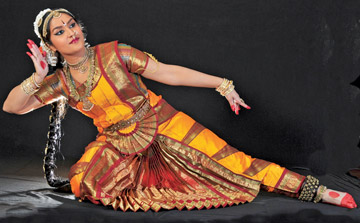Temple dancers and Indian classical dances
Subashini PATHMANATHAN
The classical dances of India are based on spiritual and religious
philosophy. The temple female dancers were called devadasis, koothier
and Sri Vaishnavamaikam in different temples. The devadasis literally
means the female servants of gods. Earlier there was a belief that the
devadasis were formally married to the god of the temple. These
devadasis who were attached to the temple.
 |
|
Devadasis
were highly regarded |
These female devadasis were dedicated to the dancing service at a
very tender age, generally before 14. The females above that age were
not allowed to enroll to serve the lord by the temple authorities. Soon
after the enrolment the girls were entitled to get a payment.
Temple service
After a ritual marriage ceremony with the presiding deity of the
temple, they could not marry or lead a normal life and was supposed to
serve as the temple devadasis.
Once they enroll themselves for the temple dance service, they were
supposed to dedicate themselves to the art forms such as music and
dance. But socially they were allowed to lead a free life. Shelter and
all the necessary arrangements and facilities were provided to the
devadasis, and for their mentors, by the state and temple authorities.
Some selective castes had a tradition to contribute at least one
female child for the service of the temple dance. The male dancers were
called Koothar, Chakaier, Araier and Gothipuas. The Indian classical
dances were mostly based on Hindu culture, tradition and Hindu
philosophy including Sivaism and Vishnavaism.
It was believed that Nathamuni who compiled the works of 12 Alwars
and published under the title of ‘Naalaaiyram Thviya Pirapantham’.
He also set the music for it and formulated the hand gestures for
abinaya. The females who danced in the Vaishnava Temples were called Sri
Vaishnava Manikam and the males were called Araier and their services
were recognized as Araier servai.
Dance, drama and music including vocal music and instrumental music
played an important role in the temples and temple rituals. These fine
arts were regarded as the temple arts. In olden days these art forms
grew, developed and flourished in the temples and around the temple
environs.
Particular period
Numerous inscriptions provide valuable information regarding how the
royal patronage was given to promote dances in the temples. Kings
generously contributed lands. Paddy, cash and kind were given to their
services. Even today there is a village in Tamil Nadu called Kootha
Nallur. This shows that the village was given to Koothar (dancers) for
their services.
There are still some references available that even the devadasis
themselves donated the lands back to the temples. The temple devadasis
were engaged in the daily temple rituals. There is evidence which shows
that after they reached a particular age and stage, they faced a
retirement ceremony by unhooking their earrings before the temple
priests. The earrings were given back to them, yet they didn’t wear
those back in their lifetime. Their life was fully secured. According to
some records the funeral pyre of the devadasis must be lit by the fire
brought from the temple. Hence the devadasis, who dedicated themselves
throughout their life were well looked after by the temples till the end
of their life.
During the events like social functions, pongal festivals, marriage
functions, auspicious functions, and sometimes in some festivals dances
of devadasis were taken place. Though dancing in temples was banned
during the British regime, yet it continued till 1947 in Tamil Nadu.
With the passage of time, the total number of performers of devadasi
clan declined due to various reasons. Temple dancers including males and
females were very much popular in certain states like Assam, Andhra,
Orissa, Manipur, Madras, Karnataka and Kerala.
Generally the dance forms were practised inside temples, before the
presiding deity or before the Utsava moorthy or within the temple
courtyard (Premises). Even in the temple itself ‘Natya Salai’, ‘Natana
Mandapam’ and ‘Nat Mandapam’ were built up to preserve and perform the
dance. Kuchupidi, Bhagavatha Mela, Bharatha Natyam, Odissi and
Koodiyattam are closely and directly linked with temple traditions and
spiritualism.
|



